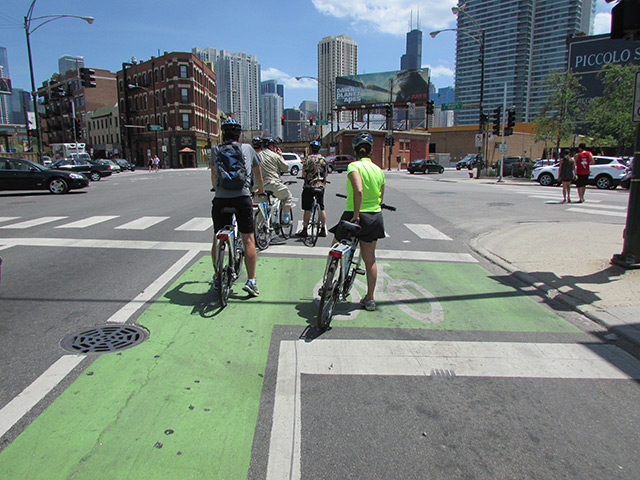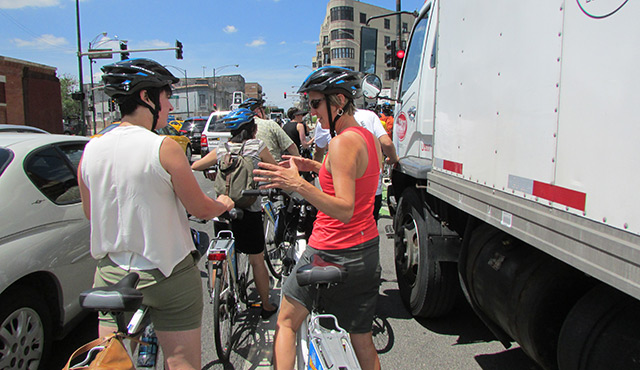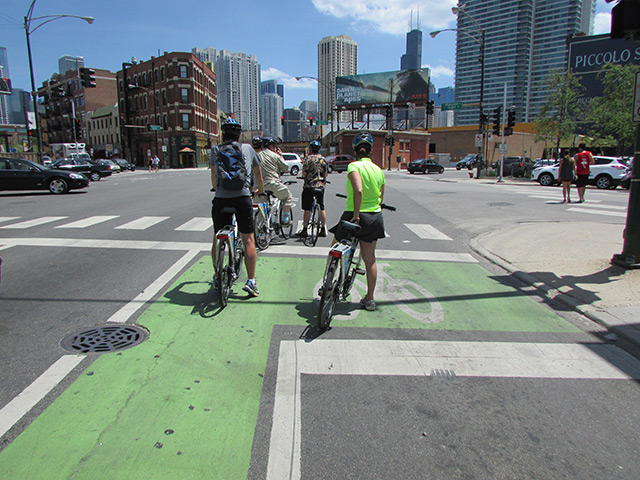
Making ‘doable’ ideas work for cities
Mia Birk is president of Alta Planning + Design and a principal of Alta Bicycle Share is a keynote speaker at “8-80 Cities Forum: The Doable City.” The Knight Foundation-sponsored conference on fostering livable cities is happening through today in Chicago. Above: Gil Penalosa speaking. Credit: Emily Munroe, 8-80 Cities.
What is “Doable?” As 8-80s Cities founder Gil Penalosa explained it to me, doable ideas are achievable, attainable, feasible, practicable, realizable, viable, workable—ones that can be adapted or evolved to each community’s unique situation. What a great pretext, right up my alley! I’ve spent the last 25 years focusing on the practical details of making bicycling and walking are safe, normal, healthy and fun daily activities. BIKING CHICAGO with and without cycle tracks


In my book, “Joyride: Pedaling Toward a Healthier Planet,” I tell the story of how a group of determined visionaries transformed Portland, Ore., into a cycling mecca and inspired the nation. The ideas upon which we based our vision were indeed doable, achievable, attainable, feasible, practicable, realizable, viable, workable. Simple really. Not particularly innovative from the standpoint of someone who has grown up in Copenhagen or Amsterdam, but so very bold for the times, for the location. The ideas we tried were innovative, challenging, even overwhelming at times.
To me, this is the very nature of change: taking well-vetted, obviously logical ideas and applying, adapting, using them for the better in new situations. For example, protected bike lanes, aka. cycle tracks, are commonplace in many cities outside of North America. But for us, they are bold, often controversial, involving painful trade-offs with public space currently dedicated to storing or moving people and goods by motorized vehicle.
So, then, the answer is not in the idea alone, but also in the process that leads to its deployment. Demonstration projects are one method. Thorough and determined public process can help. And for sure, without a doubt, you need tough and committed leaders, in three realms: political, agencies (in our field, usually public works or transportation departments), and in the community. When you have one or two of these human elements in place, you can make good progress, but when all three click together, red tape gets cut, funding gets found, and obstacles are overcome.
Take Chicago, our host city this week. What a great example. With the election of Mayor Rahm Emanuel, his appointment of Gabe Klein and now Rebeka Scheinfeld as transportation commissioner, and the Active Transportation Alliance, an already strong city for bicycle transportation began to soar. Divvy Bikes is the most prominent example, along with the push for protected bike lanes and the terrific Go Bronzeville encouragement program we have had the honor to manage. Over the last year, the Go Bronzeville program talked to 7,500 households on Chicago’s near South Side about the many benefits of using active transportation and transit.
Bronzeville is a terrific neighborhood – full of pride, vibrant history, and people who care, deeply, about their neighbors and their neighborhood. As noted on Streetsblog Chicago:
Outreach ambassadors LaKeisha Hamilton and Ronnie Harris have been giving presentations to churches, block clubs, senior centers and other community organizations, as well as organizing walking and biking events that encourage residents to get more active…
“When it comes to walking and biking, a lot of people need to be pushed, because sometimes they’ll say, ‘Oh I can’t do it,’” Hamilton says. “So we became coaches and mentors, saying, ‘Yes you can, let’s try this out.’” Obesity, heart disease and diabetes rates are especially high among African Americans, she noted. “We let people know that if you exercise more, if you get out and walk or bike instead of starting up the engine of your car, maybe we can bring those numbers down,” she says. “They’re like, ‘Yeah, I didn’t see it that way.’”
When it comes to creating the “Doable City,” that last quote is what it’s all about. Folks seeing things differently, opening their minds, or perhaps viscerally experiencing a different way of approaching transportation. Creating the “Doable City,” with joy and confidence.
Recent Content
-
Community Impactarticle ·
-
Community Impactarticle ·
-
Community Impactarticle ·


